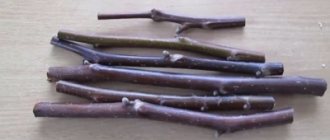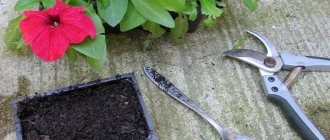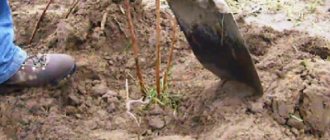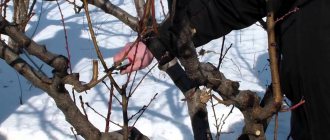The rose is beautiful with its fresh buds and light and delicate aroma. That is why the desire to have many wonderful flowers, and of various varieties, in your garden is so irresistible.
If you still don’t really know how to propagate a rose, stop with cuttings. This is one of the most realistic ways to increase your floral happiness or simply acquire a new interesting variety of rose, donated by your neighbors in the country.
You will learn about the benefits of rose cuttings, the timing of autumn cuttings, how to root rose cuttings at home, as well as other practical tips from this article.
Ways to propagate roses in autumn
Cuttings of roses in autumn are more preferable than in spring
Most methods of propagating roses are confined to the spring period, but there are also those that are acceptable in the fall. These include:
- Dividing the bush. Mature bushes with many developed shoots are suitable for this. The bush is completely removed from the ground, divided into 2-3 parts with pruning shears and planted separately. It is important that each division contains at least 3 living buds. After 2 years, full-fledged bushes grow from these parts.
- Cuttings. The most common and simplest method of reproduction. If you do this in the fall, you will need woody shoots. Cuttings of a certain length are cut from them, which are then buried in nutrient soil. They take root within 3 weeks, and are transplanted to a permanent place of growth next spring.
- Burrito method. You need to cut cuttings from the stems and, after treating the lower cut with any growth stimulant (epin, root), wrap them in damp newsprint. Then the cuttings are placed in a dark place for 3 weeks. They say that after this period, new roots appear.
- Cuttings in potatoes. Freshly cut cuttings are treated with a manganese solution and placed in water with added aloe juice. After holding for 10 hours, the blanks are stuck into potato tubers. Place this structure in a deep tray, fill it a third with earth and spill it with a weakly concentrated manganese solution. Cover the top with a glass cap.
- Rooting in a package. The cut cuttings are placed in a plastic bag with sterile soil or raw sphagnum moss. Air is blown into the bag and tied. Then they hang it near the window. Due to the greenhouse effect created inside, the roots grow within a month. After this, the cuttings are planted in a garden bed.
Storage
If autumn cuttings are stored until spring, choose one of three placement options:
- in the vegetable compartment of the refrigerator;
- in the basement;
- on open ground.
It is easier to do this in the basement, but not every amateur gardener has such a room.
Before storage in the fall, all leaves and thorns are removed from the planting material without exception, while preserving the buds, from which the vegetative mass will grow in the next growing season.
In a refrigerator
The temperature during such storage should not fall below +1°C and rise above +4°C. All planting material is tied together and placed inside a damp newspaper. Then the workpiece is placed inside a plastic bag, which is tightly wrapped with twine. In this state, moisture will not evaporate from the shoots.
Another method of storing in the refrigerator involves wrapping it in a plastic bag with perforations through which moisture gradually evaporates without forming excess condensation. This method is more troublesome, since it requires you to take out rose cuttings once a week, unwrap them and moisten them with a fine spray bottle to avoid drying out. If mold is present, the affected specimen is immediately removed so that the fungus does not affect all planting material.
In the basement
To do this, in the fall, take a box of suitable size, which is filled with a mixture of coarse sand and moistened peat. Rose cuttings are dropped into such a substrate at an angle of 45°C. The top of the box is covered with plastic film. Periodically, the substrate is checked for moisture, since its drying out can destroy all the workpieces. Moisten the soil until it remains slightly moist.
In the garden
The blanks of future roses are placed in a box made of thick cardboard, and they are covered with a layer of peat of at least 20 cm on top. These boxes are placed in the darkest place in the area where the shadow lasts the longest, since the snow cover will lie here for a long time. After the first snowfall, the box is additionally covered with a layer of snow: the higher the snowdrift, the better. To retain the snow cover and prevent it from being blown away by the wind, branches of coniferous trees are laid on top.
For regions where frosts in winter stay below -30°C for longer than a day, it is necessary to wrap the box with burlap or spunbond to prevent complete freezing.
Advantages and disadvantages of autumn planting roses from cuttings
Using the cutting method, you can preserve the varietal qualities of the plant
The most common options for propagating roses are grafting and cuttings. However, the latter option has a number of advantages over the first:
- the plant will no longer have abundant root growth, which greatly facilitates maintenance;
- frost resistance and the ability to independently recover with the first warmth of spring, even in the event of freezing;
- the possibility of obtaining a large amount of planting material;
- longer lifespan of roses planted from cuttings.
There is only one drawback - only the planted cuttings do not all survive the first winter safely, since they do not have time to fully grow the root ball. Therefore, it is recommended to send the first-year plants to the cellar for the winter, buried in a container with nutrient soil.
Tips for growing roses from cuttings
To safely accelerate the growth of roses in the fall, you must remember:
- It is advisable to take cuttings from flowers in early summer or spring, when the crop is at its peak of development. The parts for propagating roses are separated from the shoot in the autumn, at the time of pruning old bushes.
- You need to know what soil the flower prefers. This culture does not develop well on clayey and acidic soils, so sand, leafy and turf soil, as well as humus are used to prepare the nutrient substrate. Before planting roses, be sure to disinfect them with a manganese solution.
- Moisten the soil as the top layer dries out. In addition, you need to ventilate the plants, remove the film cover or jar.
Important! For better formation of the root system of roses, add a few drops of the drug “Kornevin” or “Epin” to a jar of water where the cuttings stand.
Which roses can be propagated using autumn rooting of cuttings
Whatever the variety, you can use cuttings when the plant has already opened buds
The following varieties of roses can be rooted without any problems:
- climbing;
- polyanthas and their hybrids;
- miniature;
- hybrid tea;
- floribunda (varieties “Rosalind” and “Iceberg”).
Remontant, park and most varieties of yellow roses are difficult to take cuttings.
What varieties of roses are suitable for cuttings?
Before cuttings, you need to decide on the varieties of roses that can be used for propagation. Each of the flower subspecies has its own strengths and weaknesses. In some plants, cuttings take root better; in others, the rooting process slows down.
The following types of plants are excellent for propagation in autumn:
- polyanthus and dwarf varieties;
- semi-climbing roses;
- varieties Iceberg, Excelsa, Rosalind.
In addition to these species, hybrid tea roses are suitable for propagation in autumn, but they form an underdeveloped root system. Experienced gardeners recommend growing such plants by grafting rather than cuttings. Climbing, remontant, and park crops are much more difficult to propagate from shoots, since the number of rooted shoots does not exceed 40%.
Important! Before cutting the desired variety of roses, you need to find out all the information about the plant, pay attention to its disadvantages and advantages.
Roses are grown in the fall from cuttings after pruning the bush. This method is simpler than propagating the crop by grafting or seeds.
Timing of autumn cuttings
The timing of cuttings depends on weather and climatic conditions
Cuttings of roses in the fall are usually combined with pruning. This procedure occurs at the end of October - beginning of November (in the southern regions). But in the middle zone, Moscow region and in the North, pruning with cuttings is recommended to be carried out from mid to late September.
Then it is considered fully ripe.
If you focus on the Lunar calendar, then here are the most favorable days in 2021 for cuttings: August - 2-5, September - 3.4, from 17 to 19, 30.
Plant care after cuttings
When planting cuttings in open ground in the fall, you need to take care of reliable shelter for the cuttings.
To do this, build a mini-greenhouse according to the following scheme:
- Cover the plantings with coniferous branches.
- Install metal arcs at a distance of 50 cm from each other above the planting.
- Cover the top of the arc with agrofibre.
- Press down the hanging edges of the agrofibre with boards or bricks.
- Cover the mini-greenhouse with fallen leaves.
- As soon as the snow falls, cover the greenhouse with it.
When planting in a permanent place in open ground, such shelters must be built over each plant. With the arrival of spring, the shelter is removed layer by layer, focusing on the temperature regime. As the temperature rises to +10°C, remove the first layer of shelter, and then one layer every 5–7 days.
When planting in containers, it is important to ensure that the temperature on the balcony is 5 degrees higher than the outside temperature. When the room temperature drops to -5°C, it is better to cover the plantings with old clothes or bring them into the apartment for a short time.
Did you know? To produce 1 liter of rose oil, you need to spend about 3 tons of petals.
In the spring, 2 weeks before transplanting the rooted cuttings into the ground, dig up the area and water it with a 1% solution of copper sulfate. After 2 days, dig up the soil again, add 10 kg of sand and compost for every 1 m². After 10 days, dig up the soil again, level the area and make a convenient marking for the flowerbed.
Add 10 g of superphosphate to each well.
To plant, mix the soil from the holes with rotted manure, add 400 g of wood ash for every 10 kg of soil. Water the plants 2-3 hours before planting. After removing the seedlings from the soil, assess the condition of the root system, treat with Kornevin mixed with activated carbon and Fundazol.
After transplanting, water the plants with a small amount of water, approximately 300–400 ml per hole.
Carry out the first full watering after transplantation after 2 weeks. At the same moment, you can carefully remove the layer of wax that was used to treat the upper end of the seedling. Start applying fertilizers a month after planting. You can use universal fertilizer for roses.
For the first time, dilute them in a concentration 2 times less than indicated in the instructions. With each subsequent time, increase the dosage by 10%, bringing it to the maximum.
Plants develop and bloom well when mineral complexes applied foliarly alternate with root feeding with organic matter (slurry diluted with water in a ratio of 1:2). During the bud formation phase, it is best to feed the plants with phosphorus compounds, abandoning nitrogen fertilizers.
In this regard, potassium monophosphate has proven itself well. It is diluted with water in a ratio of 1:3 and used as root and foliar feeding. Watering is carried out moderately, about once a week, after the upper earthen ball has dried to a depth of 3–5 cm.
It will also be useful for you to learn how to properly grow roses from seeds.
Preparation of planting material
When choosing branches you need to pay attention to their thickness
Chubuki for autumn propagation of roses are prepared from shoots that have not yet completely become lignified. This is how they look at the beginning of flowering. Stems that are completely green or hardened are more difficult to take root.
How to properly cut cuttings (chubuks) of roses for propagation
For cuttings, select one-year-old bushes with well-developed and even stems, about 5 mm thick. Divide them into several segments 20–25 cm long (use sharp garden tools). On each resulting division there must be at least five living internodes.
To make the first cut, step back approximately 2 cm from the top bud and cut evenly. Then measure the required length of the cutting and cut the shoot diagonally directly under the lower bud.
If you plan to plant cuttings immediately, then they are completely cleared of foliage. When planting is postponed, some of the leaves should be left to feed the plant.
How to divide a rose bush for propagation in the fall
When propagating roses by dividing the bush, it is dug up along with the roots. Then lightly shake off the ground to understand the condition of the root system. If damage is found, remove it.
Using pruning shears, cut the bush into the required number of parts. Each one should have its own roots. One shoot with 3–5 buds is left, the rest are cut to the base. After this, the wounds are treated with garden varnish, the roots are dipped in clay-manure slurry and planted in the ground.
Planting cuttings in the fall at home
If for some reason it was not possible to plant the cuttings in open ground or a greenhouse at the dacha, then they can be successfully rooted at home. Regular flower pots or containers for seedlings are suitable for this.
Prepare the soil according to all the rules: place drainage down, sprinkle it with a layer of fertile soil, one-third consisting of sand. The cuttings are planted in containers at an angle, as in summer cottages.
The seedlings are covered on top with either plastic bottles or glass jars. Ventilate periodically and water moderately. In severe frosts, transfer to a warmer room. With the establishment of warm spring weather, they are transplanted into beds and flower beds.
Rooting cuttings and autumn planting
You should follow the recommendations of experienced gardeners to get good results.
Rooting of chibuks can take place in two ways:
- at home they are planted in a regular flower pot and wait for fresh roots to form;
- Immediately dug in the garden.
Cuttings and planting roses in open ground in autumn
To plant roses, the soil on the site must be moisture- and breathable. The best option would be a combination of turf and leaf soil with the inclusion of sand and rotted mullein. Approximate composition:
- garden soil mixture (2 parts);
- leaf compost (1 part);
- river sand (1 part).
Additionally, sand is scattered over the bed in a layer of 3–4 cm.
Then proceed as follows:
- The finished cuttings are treated from below with any stimulant drug (root, heteroauxin).
- Dig a hole up to 30–35 cm deep and fill it a third with grass, sprinkling compost on top.
- Place the shoot at an angle so that 2-3 buds remain above the surface. Then they bury it.
- Upon completion of the procedure, the planted area is watered abundantly.
To protect the shoots from sudden cold snaps, each of them is covered with a glass or plastic cap. Then they are covered with any plant waste from the garden and covered with non-woven material. If the region has frosty and snowless winters, it is advisable to additionally insulate the cuttings with straw.
Video: Basic rules for cutting roses in autumn
Planting cuttings in the fall at home
This option for rooting cuttings is suitable for city residents. For planting, you will need any spacious container (box, bucket, basin). A layer of expanded clay (drainage) 5 cm thick is poured onto the bottom, then nutrient soil. As a last resort, you can buy ready-made soil for roses and mix perlite (vermiculite) into it. Immediately before the planting process, the soil in the pot is moistened.
Further sequence of steps:
- As in the previous case, chibuki are prepared in early November.
- Dip the top of each piece in melted wax and cold water (so that the shoots do not start growing prematurely). After this, the cuttings are lowered one by one into the root solution and stuck into the prepared holes.
- They stretch the film over the top and then wrap it with a blanket. This structure is placed on a glazed loggia or terrace.
You cannot place a container with cuttings on bare concrete. You must first place boards or a sheet of foam on the floor. On frosty nights, the chibouks are brought indoors.
Advice from experienced flower growers
Take advantage of the advice of experienced gardeners who will help you create a lush rose garden in your garden:
- If the cuttings have dead, dry, brown shoots, cut them obliquely to the first dormant bud.
- The depth of the planting hole must be sufficient to accommodate the root system.
- Bury the grafting site 4-5 cm into the ground, then carefully fill the hole with clean soil and water it generously.
- If the rose's root system is wrapped in biodegradable material, plant the cuttings directly in it.
- Remove broken, non-viable and diseased roots, treat the sections with a biofungicide solution (Ampelomycin, Fitosporina, Mikosana, Glyokladina).
- Before planting, trim the roots by 2 cm to reveal the core. It should be light, without dark inclusions.
- Remove paraffin from cuttings before planting so as not to interfere with roses growing and breathing.
- Pre-soak the cuttings in clean water for 2-3 hours to replenish the moisture deficiency. Add a growth stimulator and make sure the root collar remains above the surface of the water. Then move the seedlings into a solution of copper sulfate for disinfection for 30 minutes.
- Choose areas for planting on slopes at an angle of 8–10°.
- After planting, shade the seedlings from direct sunlight (for example, with cardboard). After glossy leaves appear, remove the cover. This means that the roses have begun to grow and no longer need shading.
- Too wet, acidic, sandy soil with a high salt content is not suitable for planting roses. To normalize the pH, add slaked lime or dolomite flour (400–500 g per 1 m²). The optimal soil acidity is slightly acidic (pH 5.5–6.5).
- Maintain distance between bushes and do not plant cuttings too close. Closing foliage leads to the development of fungal infections. The optimal distance between bushes is 50–100 cm.
How to save cuttings in winter until spring planting
When the cuttings have already been prepared, but they are planned to be planted only in the spring, it is important to be able to keep them intact. To help them survive the winter safely, do the following:
- In the garden, dig a shallow hole and line it with a cotton cloth with a margin on the sides. The cuttings are evenly laid out on it and covered with the same cloth. After this they are covered with earth.
- In the spring, immediately after the snow cover melts, cuttings are dug up and examined. A growth (callus) with fresh roots should form on viable shoots.
- The stems removed after wintering are immediately planted in a permanent place or in cuttings for growing. If the procedure is postponed for 1–2 days, then immerse them in water with the addition of epin.
Many gardeners, in order not to take risks, prefer to root cuttings in boxes and store them in the basement or cellar throughout the winter. It is important that there is good ventilation and the temperature is kept within +1–3 °C.
Even a novice gardener can propagate roses from cuttings, since the procedure is extremely simple and not labor-intensive. The main thing is to initially choose the right variety and strictly adhere to the standard rules for rooting cuttings. Then after 2-3 years you will be able to admire the first full flowering.
- Author: fhntv2002
Rate this article:
- 5
- 4
- 3
- 2
- 1
(36 votes, average: 3.7 out of 5)
Share with your friends!
Features of planting ready-made cuttings in open ground
After autumn cutting, it is recommended to plant the prepared cuttings immediately in a permanent place. This will result in less stress for future rose bushes and will provide them with better survival, as well as eliminate the hassle associated with subsequent replanting.
Another acceptable option is planting in a cutting bed (a specially prepared bed).
Choosing a landing site
The choice of location for planting cuttings in the garden plot is made taking into account the individual preferences of the plant. The queen of the garden has a rather fastidious disposition and is sensitive to a deficiency of any nutrients in the soil. That is why it is very important to properly prepare the soil and choose the most optimal location.
Basic rose requirements:
- well-lit and warm place;
- protection from cold piercing winds;
- loose and fertile soil;
- low groundwater level.
Taking into account the listed requirements, it is recommended to plant pink cuttings along fences or walls, in a dry place. You should not place the rose garden under trees, as the shadow cast from them will have a negative impact on the flowering of the plant: few buds, small and faded flowers. If the quality of the soil on the site leaves much to be desired, it is necessary to take care of its improvement in advance: dig it up, loosen it and fertilize it.
Planting cuttings in the ground
Rooting of cut cuttings is carried out according to the following scheme:
- Dip the lower cut of the branch into a preparation that stimulates root formation: “Kornevin”, “Heteroauxin”. Root formers can be used both in powder and solution form.
- Prepare holes 25 - 30 cm deep. Line the bottom with mowed grass, about a third of the depth. Place a layer of compost or rotted manure on top of the hay and water the planting hole with water.
- Insert the finished cuttings in the center of the hole (one cutting - one hole), at a slight slope (up to 45º). Sprinkle the branches with soil and compact it. Water future plants.
As a result of all the actions taken, approximately a third of the pink cutting with 1-2 buds should remain above the surface of the earth.
The key to successful rooting of cuttings in the fall is high humidity - at the level of 80% - 90%. It is easy to organize by covering each specimen with a plastic or glass container(s). The container should be transparent so that the cuttings receive enough light. The containers act as a greenhouse: inside them a microclimate favorable for the survival and germination of seedlings is created. The jars are left until spring.
Cuttings grown in cuttings can be planted in a permanent place only after a year, next fall. During this year they should gain strength and form a good and strong root system.
It is recommended to complete cuttings with rooting a week before the onset of stable frosts.
Preparing cuttings for wintering
Winter is quite a serious test for cuttings planted in the ground in the fall. In order for the seedlings to winter safely, it is necessary to properly prepare them for future cold and frost.
First, cuttings in improvised greenhouses are sprinkled with dry leaves or peat. Then cover with non-woven material. Straw or spruce spruce branches are used as insulation - they are placed on top of the canvas. Closer to winter or already in winter, covered seedlings are additionally sprinkled with a good layer of snow as soon as it falls.
If rose cuttings were planted in a cutting box, a small greenhouse is built above it. The frame of the greenhouse is created from arched metal rods and covered with waterproof material (polyethylene film, lutrasil, agrofibre). The covering material is well secured on the sides to prevent cold air from entering the greenhouse. Then do the same: sprinkle with humus or leaves, cover with spruce branches, throw on snow.
Sheltering rose cuttings for the winter
When spring comes, the layers of the greenhouse are gradually removed. First of all, they get rid of the snow, then they remove the spruce branches, after which they gradually open the plantings themselves.











